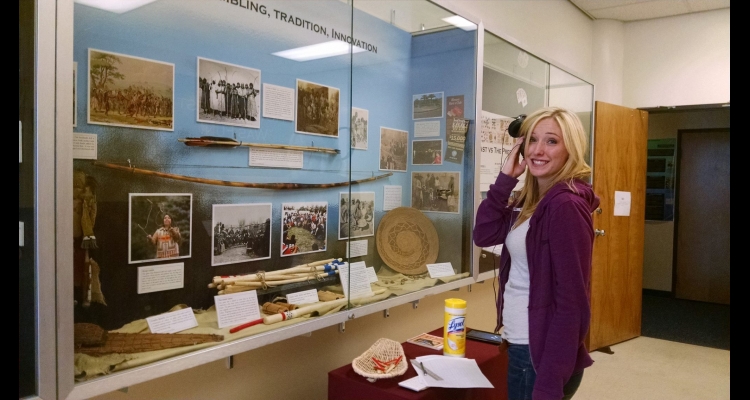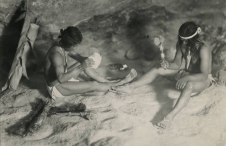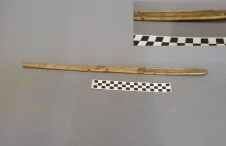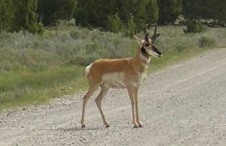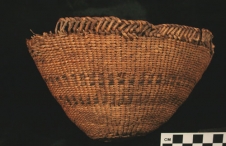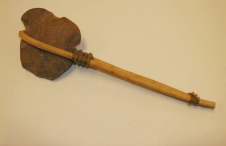A Story of Encounters: Topics of Archeological and Anthropological Study
Beginning in the early decades of the twentieth century, researchers produced an extraordinary amount of knowledge about Nevada’s indigenous cultures. Archeological excavations explored ancient housing in caves and Pueblo (Anasazi) ruins and uncovered artifacts including ancient clothing, tools, and weapons like the atlatl. These sites and objects yielded information about prehistoric cultural practices ranging from salt mining and trading to antelope drives and seasonal settlement patterns.
At the same time, many anthropologists, ethnologists, and oral historians worked closely with tribal members to record detailed firsthand accounts of their experiences and to document traditional practices including rabbit drives, basket making, and annual harvests.
Many artifacts and excavated materials, ethnographic materials, and assorted collections related to these anthropological and archaeological studies have found a home in the Nevada State Museum in Carson City and the Anthropology Research Museum at the University of Nevada, Reno, among other repositories.
See below for articles and other materials related to this topic.
VIDEOS
Tah Gum -- University of Nevada Oral History Program documentary, 1999
For thousands of years, tah gum (pine nuts) have been a staple in the winter diet of the Washoe Indians. Eight generations after Euro-Americans moved into their territory, the Washoe still gather in small groups every autumn to harvest pine nuts. Filmed in pinyon-juniper forests east of the Sierra Nevada, Tah Gum accompanies a group of Washoe women as they gather pine nuts, roast them, and talk about the old days. Historic photos and film footage from the 1940s illustrate the evolution of pine-nut gathering and processing in the twentieth century and some of the social atmosphere surrounding the activities. The film ends with a feast of Washoe traditional foods, including pine-nut soup.
Under One Sky -- University of Nevada Oral History Program documentary, 2006
As told by Northern Paiute, Western Shoshone, and Washoe people, Under One Sky presents "Origin Stories," "Life Ways," and memories of experiences at the Stewart Indian School in Carson City. "Origin Stories" explains the people's presence on the land and their relationship to it, while "Life Ways" illustrates some important changes that have occurred since non-Indian settlers first penetrated traditional Indian territories. These vignettes were filmed on site in spectacular Great Basin locales and on the eastern front of the Sierra Nevada. They incorporate historical photographs and footage from vintage home movies. Traditional tribal songs enrich the sound track, and English subtitles are provided for passages that are spoken in native tongues.
Rabbit Boss -- University of Nevada Oral History Program documentary, 1995
Rabbit Boss is a short documentary exploring an important dimension of American Indian life in the Great Basin. Every autumn, in sagebrush valleys east of the Sierra Nevada, Washoe Indians renew a connection with their natural environment. When the time is right, a leader known as the "rabbit boss" assembles a group of hunters to move through the brush, driving jackrabbits before them. As in the past, the rabbits are killed for their meat and pelts. Rabbit Boss follows the leader at the time, Marvin Dressler, on three rabbit drives in the basin-and-range country of the Washoe homeland. On-site footage and historic photos show how the rabbit drive has survived the twentieth century transformation of Washoe life, and excerpts from a decades-old home movie record the making of one of the last of the rabbit skin blankets.
ORAL HISTORY
James Calhoun and the Nevada State Museum
James W. Calhoun served as director of the Nevada State Museum in Carson City from 1950 to 1973. Among his other responsibilities, Calhoun participated in museum-led archaeological digs including excavations at Tule Springs and Lost City. He also spearheaded the creation of the museum’s anthropology department in 1959 and the introduction of the Nevada State Museum anthropological papers. Under Calhoun’s direction, the museum’s focus changed from that of an institution interested only in displaying historic relics to one interested in research and educating the public.
The University of the Nevada, Reno Anthropology Research Museum
Interviewed in 2002, Dr. Catherine S. Fowler and Dr. Donald L. Hardesty of the Department of Anthropology at the University of Nevada, Reno discuss the development, collections, and educational goals of the department’s Anthropology Research Museum, which was founded in 1980.
The Margaret M. Wheat Collection
Special Collections Department, University of Nevada, Reno
This selection of oral history interviews represents a cross-section of Paiute and Shoshone members’ recollections recorded by Margaret (Peg) Wheat during her ethnographic work in the 1950s and 1960s.
ARTICLES FROM THE NEVADA HISTORICAL SOCIETY QUARTERLY
Articles reprinted with permission from the Nevada Historical Society. Select a link to open a pdf copy of the article.
Article Locations
Related Articles
Further Reading
None at this time.

